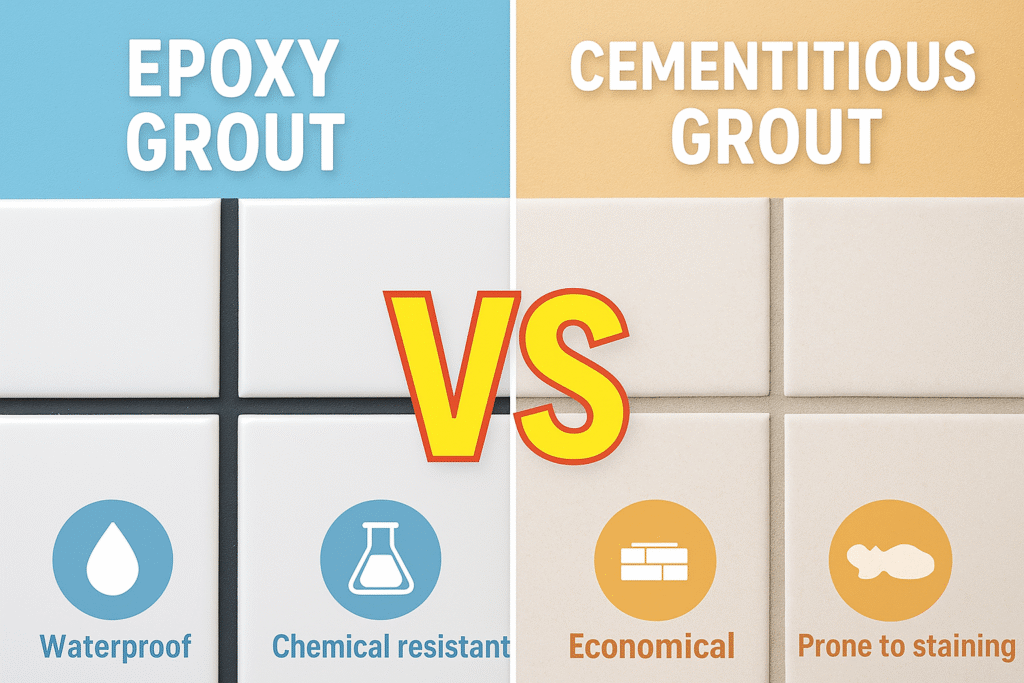Introduction
Grouts are a crucial component of tile and stone installation they occupy joints, add strength, and affect the performance and appearance of tiled finishes. In the varied construction scene of India, selecting the optimum type of grout is key, keeping in mind factors such as humidity, usage, temperature fluctuations, and application.
Cementitious grout and epoxy grout are the two most commonly utilized types of grout. Both serve their purposes, but with differing performance, longevity, and price.
This blog will attempt to clarify the distinctions between epoxy and cementitious grouts, and help you select what will be best for your project be it a Mumbai luxury apartment, Gujarat industrial kitchen, or coastal home bathroom.
What Is Grout and Why Does It Matter?
Grout is that substance applied between tiles once they are installed. Its role is not merely to fill out the visual pattern, but to:
Prevent water penetration
- Improve structural integrity
- Reduce movement or cracking
- Maintain sanitary conditions (particularly in kitchens/bathrooms)
In Indian conditions which can be dry and dusty or hot and humid the proper grout can determine a tiled surface lasting years or collapsing within months.
Cementitious Grout
What is it?
Cementitious grout is the old-fashioned grout from a mixture of cement, water, sand, and additives. It’s commonly used for residential and low-traffic installations.
Pros:
- Inexpensive and readily available
- Easy to mix and apply
- Suitable for internal walls and dry spaces
- Breathable enables moisture to evaporate (useful in old buildings)
Cons:
- Poriferous – soaks up water and stains readily
- Tends to crack or shrink with age
- Needs frequent sealing to remain protected
- Not ideal for chemical-intensive or water-vulnerable spaces (e.g., bathrooms, industrial areas, swimming pools)
Best Used For:
- Home flooring for low-traffic spaces
- Internal wall tiles
- Budget-friendly projects
- Spaces where there is proper sealing and little exposure to water or grease
Epoxy Grout
What is it?
Epoxy grout consists of epoxy resins and a hardener, thus being extremely durable, stain-resistant, and practically non-porous. It’s a high-end product used in commercial, industrial, and high-performance environments.
Benefits:
- Waterproof and stain-proof
- Very strong and durable
- Chemical-resistant, grease, and acid-resistant
- Non-porous – hygienic and easy cleaning
- Colour-consistent and low-maintenance
Drawbacks:
- Higher cost than cementitious grout
- Marginally harder to apply – needs skilled applicators
- Shorter working time before it begins to cure
- Shorter working time before it begins to cure
- Could appear a bit “plastic-like” if aesthetics are not managed properly
Best Used For:
- Commercial kitchens, restaurants, and food processing units
- Bathrooms, swimming pools, and wet areas
- High-end residential projects
- High-end residential projects
- Chemically exposed areas or heavy traffic areas
Grouting Considerations for Indian Conditions
India’s varied climatic zones, construction practices, and usage requirements make grouting a performance-critical process. Here’s how each type of grout performs under Indian conditions:
Hot and Dry Regions (e.g., Rajasthan, Central India)
- Cementitious grout can become too dry too fast, causing shrinkage or cracking.
- Epoxy grout maintains strength and flexibility more dependable in the long term.
Humid/Coastal Regions (e.g., Kerala, Mumbai, Chennai)
- Cementitious grout absorbs water and grows mold/mildew.
- Epoxy grout is water-resistant and microbe-resistant perfect for balconies and bathrooms.
Urban High-Traffic Areas (e.g., Apartments, Commercial Areas)
- Cementitious grout deteriorates sooner in high-traffic areas.
- Epoxy grout resists wear and lasts for appearance for years perfect for malls, lobbies.
Industrial/Commercial Kitchens
- Epoxy grout is a necessity oil-resistant, stain-resistant, acid-resistant, and easy to clean frequently.
- Cementitious grout does not hold up to chemical exposure and is difficult to clean.
Cost Comparison
| Grout Type | Initial Cost | Labour Intensity | Maintenance Cost | Life Span |
| Cementitious | Low | Low | Moderate–High | 5–8 years |
| Epoxy | High | Medium–High | Very Low | 10–15 years |
Though epoxy grout is more expensive up front, it is worth the cost in durability and reduced maintenance over time. Cementitious grout is still an intelligent option for budget-friendly, low-risk applications.
Tips for Selecting the Proper Grout
- Determine the area – Is it wet, dry, indoor, or outdoor?
- Look at the foot traffic – High-traffic areas require high-performance grout.
- Examine hygiene needs – Kitchens and hospitals should use epoxy.
- Think about aesthetics – Cementitious grouts leave a natural finish; epoxy has a sharper one.
- Consider maintenance – Do you seal and clean often or be low-maintenance?
Installation Advice
- Apply epoxy grout by skilled laborers because of rapid setting time and sensitivity to mixing.
- Cementitious grout is less critical and more accessible for everyday masons to work with.
- Be sure to respect the manufacturer’s recommendations regarding surface preparation, mix ratio, curing time, and cleaning techniques.
- Utilize color-matched or contrasting grout depending on design intent both are popular in contemporary interior design.
Conclusion
Epoxy and cementitious grouts are both used for different functions in construction and no single solution fits all. The ideal choice will vary based on your project’s location, intended use, price point, and desired lifespan.
For wet areas, commercial-grade kitchens, and upscale interiors, epoxy grout is impossible to beat in terms of performance and longevity. For dry areas, ornamental walls, or budget-sensitive projects, cementitious grout is a tried-and-true standby.
Getting to understand the strengths and compromises of each type will help you pick a grout which enhances the structure’s strength, look, and durability in the long run particularly under Indian conditions.

